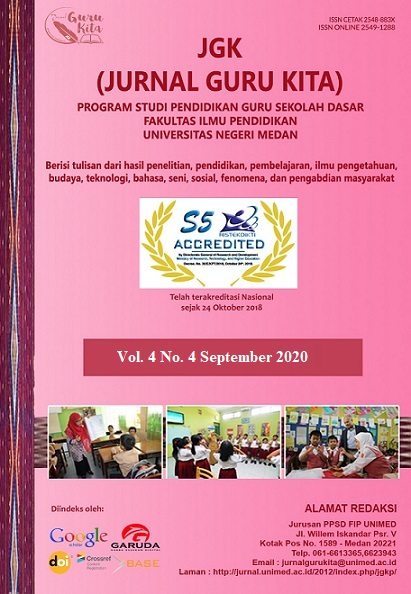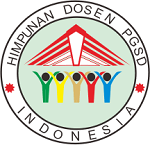PENGARUH SARANA BELAJAR INOVASI PEMBELAJARAN DAN MOTIVASI TERHADAP EFEKTIFITAS PEMBELAJARAN DARING DI MTsS SE-KECAMATAN DOLOK BATU NANGGAR KABUPATEN SIMALUNGUN
DOI:
https://doi.org/10.24114/jgk.v6i3.33814Keywords:
Learning Facilities, Learning Innovation, Motivation, and Learning EffectivenessAbstract
The Effect Of Learning Innovations And Motivation On Learning Effectiveness Online At Mtss In Dolok Batu District Nanggar Simalungun Regency. This study aims to analyze the effect of: learning facilities, learning innovation, motivation on the effectiveness of online learning and the effect of learning tools for learning innovation and motivation together on the effectiveness of online learning in MTsS in Dolok Batu Nanggar district, Simalungun district. The population in this study were all teachers at MTsS in Dolok Batu Nanggar District, Simalungun Regency, which amounted to 144 people. Based on the results of the calculation of the Slovin formula, it is known that the number of samples to be studied is 59 respondents. The sampling technique in this research was done by random sampling technique. Data collection methods used in this study were questionnaires, interviews, observation and documentation studies. Furthermore, validity and reliability tests were carried out. The data analysis technique used was multiple linear regression, the coefficient of determination, hypothesis testing directly with the F test and partially with the t test. The results showed that: The results of partial hypothesis testing showed that the tcount for the Learning Facilities variable was 2,343 and ttable with = 5% was known to be 1.67, thus tcount was greater than ttable and the significant value for Learning Facilities was 0.023 < 0.05, meaning that from the results From this it can be concluded that H0 is rejected (Ha is accepted). The results of the partial hypothesis test show that the tcount value of the control variable is 2,963 and the t table with alpha = 5% is considered to be 1.67, so that the t count is greater than t table and a significant monitoring value is 0.004 < 0.05, which means that it can be concluded from the findings. that H0 is rejected (Ha is accepted). The results of the partial hypothesis test show that the tcount value for the learning motivation variable is 2.619 and ttable with = 5% is known to be 1.67, thus tcount is greater than ttable and the significant value of Learning Motivation is 0.011 < 0.05, meaning that from these results it can be concluded that H0 is rejected (Ha is accepted). The results of simultaneous hypothesis testing show that the Fcount for the variables Learning Facilities, Learning Innovation and Learning Motivation is 7.497 and Ftable with = 5% is known to be 2.77, thus Fcount is greater than Ftable, meaning that from these results it can be concluded that H0 is rejected ( Ha accepted) indicates that Learning Facilities, Learning Innovation and Learning Motivation together have a significant effect on Learning Effectiveness at MTsS in Dolok Batu Nanggar District, Simalungun RegencyKeywords: Learning Facilities, Learning Innovation, Motivation, and Learning EffectivenessAbstrak: Pengaruh Sarana Belajar Inovasi Pembelajaran dan Motivasi Terhadap Efektifitas Pembelajaran Daring di Mtss Se-Kecamatan Dolok Batu Nanggar Kabupaten Simalungun. Penelitian ini bertujuan untuk menganalisis pengaruh: Sarana belajar, Inovasi Belajar, Motivasi terhadap Efektifitas Pembelajaran Daring dan pengaruh Sarana Belajar Inovasi Belajar dan Motivasi secara bersama-sama terhadap Efektifitas Pembelajaran Daring di MTsS Se-Kecamatan Dolok Batu Nanggar Kabupaten Simalungun. Populasi dalam penelitian ini adalah seluruh guru yang ada pada MTsS Se-Kecamatan Dolok Batu Nanggar Kabupaten Simalungun, yang berjumlah 144 Orang. Berdasarkan hasil perhitungan rumus slovin maka di ketahui jumlah sampel yang akan di teliti sebanyak 59 responden. Teknik pengambilan sampel dalam penelitian ini dilakukan dengan teknik random sampling. Metode pengumpulan data yang digunakan dalam penelitian ini adalah angket, wawancara, observasi dan studi dokumentasi. Selanjutnya dilakukan uji validitas, reabilitas, Teknik analisis data yang digunakan adalah regresi linear berganda, Koefisien Determinasi, uji hipotesis secara langsung dengan uji F dan secara parsial dengan uji t. Hasil penelitian menunjukkan bahwa: Hasil uji hipotesis secara parsial menunjukkan bahwa nilai thitunguntukvariabelSarana Belajar adalah2,343danttabeldenganα = 5% diketahui sebesar 1,67 dengan demikian thitung lebih besar dari ttabel dannilai signifikan Sarana Belajar 0.023 < 0.05 artinya darihasil tersebut didapat kesimpulan bahwa H0ditolak (Haditerima). HasilujihipotesissecaraparsialmenunjukkanbahwanilaithitungVariabelkontrolsebesar 2,963 dan t tabel dengan alpha = 5% dianggap sebesar 1,67, sehingga t hitunglebihbesardarittabeldannilaipengawasanyangsignifikansebesar0.004 < 0.05yangberartidapatdisimpulkandaritemuantersebutbahwaH0adalahditolak(Haditerima). Hasiluji hipotesis secara parsial menunjukkan bahwa nilai thitung untuk variabel Motivasi belajar adalah2,619 danttabeldenganα=5%diketahuisebesar1,67dengandemikianthitunglebihbesardarittabeldannilaisignifikanMotivasi Belajar sebesar0.011 < 0.05 artinya dari hasil tersebut didapat kesimpulan bahwa H0ditolak (Haditerima). Hasilujihipotesissecarasimultan menunjukkan bahwa nilai Fhitung untuk variabel Sarana Belajar,Inovasi pembelajaran dan Motivasi Belajar adalah 7,497 dan Ftabeldengan α = 5% diketahuisebesar 2,77 dengan demikian Fhitunglebih besar dari FtabelartinyadarihasiltersebutdidapatkesimpulanbahwaH0 ditolak (Haditerima) menunjukkan bahwa Sarana Belajar,Inovasi pembelajaran dan Motivasi Belajar secarabersama-samaberpengaruhsignifikanterhadapEfektifitas Pembelajaran padaMTsS Se-Kecamatan Dolok Batu Nanggar Kabupaten SimalungunReferences
A.M, Sardiman. 2007. Interaksi dan Motivasi Belajar Mengajar. Jakarta : RajaGrafindo Persada.
Arikunto Suharsimi, 2003, Dasar-dasar Evaluasi Pendidikan, Edisi Revisi; Jakarta Bumi Aksara
Aqid, Zainal. 2010. Profesionalisme Guru Dalam Pembelajaran. Surabaya: InsanCendikia
Arikuto Suharsimi, 2013, Organisasi dan Administrasi Pendidika Teknologi dan KeGuruan, Cet II, Jakarta : PT Geakindo.
Bafadal, Ibrahim. 2014. Pengelolaan perpustakaan sekolah. Jakarta : BumiAksara
Depdiknas, (2003), Undang-Undang Nomor 20/2003 Tentang Sisdiknas, Jakarta.
Depdiknas, (2005), Undang-Undang Nomor 19/2005 Tentang Standar Nasional Pendidikan, Jakarta.
Depdiknas, (2005), Undang-Undang Nomor 14/2005 Tentang Guru Dan Dosen, Jakarta, Sinar Grafika.
Depdiknas, (2007). Kamus Besar Bahasa Indonesia.
Fathurrohman, Pupuh. 2014. œStrategi Belajar Mengajar: Strategi Mewujudkan Pembelajaran Bermakna Melalui Pemahaman Konsep Umum dan Islami. Bandung: Redaksi Refika Aditama.
Hamalik, Oemar. (2003). Proses Belajar Mengajar. Jakarta: PT. Bumi Aksara.
Hamalik, Oemar. (2014). Proses Belajar Mengajar. Jakarta: PT. Bumi Aksara.
Karim Annisa Rahmatul : Pengaruh Pemanfaatan Sarana Terhadap Efektivitas Pendidikan Pelajaran Agama Islam di SMP Negeri 2 Tarik Sidoarjo, http://digilib.uinsby.ac.id/32984/2/Anisa%20Rahmatul%20Karim_D93215064.pdf
Kasan, Tholib . 2000. Teori dan Aplikasi Administrasi Pendidikan. Jakarta: Studia Press.
Kuntarto, E. (2017). Keefektifan Model Pembelajaran Daring Dalam Perkuliahan Bahasa Indonesia Di Perguruan Tinggi. Indonesian Language Education andLiterature, 03, 102.
Mulyasa. 2004. Manajemen Berbasis Sekolah : Konsep, Strategi, dan Implementasi. Bandung: PT Remaja Rosdakary
Purwanto, Ngalim. 2007. Psikologi Pendidikan Remaja. Bandung: Rosdakarya
Sugiono, 2003,Metode Penelitian Kuantitatif Kualitatif dan R&D, Bandung: Alfabeta.
Sugiyono, (2009), Metode Penelitian Kuantitatif Kualitatif Dan R & D, Bandung, Alfabeta.
Suhendra, B, (1996). Kebijakan Pemerintah Dalam Peningkatan Mutu Pendidikan Tinggi di Indonesia. Makalah dalam Seminar Nasional Mempersiapkan Mutu Pendidikan Tinggi Menuju Kualitas Global di Universitas Merdeka Malang 11-12 Nopember.Rinehard.
Santoso, Singgih. 2012. Panduan Lengkap SPSS Versi 20. Jakarta: PT Elex Media. Komputindo
Suhana, Cucu. 2014. Konsep Strategi Pembelajaran (Edisi Revisi). Bandung: RefikaAditama.
Tolib, Abdul (2008), Strategi Implementasi Kebijakan Implementasi Peningkatan Mutu Berbasis Sekolah (MPMBS) Dengan Pendekatan Manajemen Mutu Terpadu Pada Sekolah Menengah Pertama, Bandung, UPI.
Undang-undang Republik Indonesia Nomor 20 Tahun 2003, Undang-Undang tentang Sistem Pendidikan Nasional Jakarta : Sinar Grafika
Winkel, W. S. 2004. Psikologi Pendidikan dan Evaluasi Belajar. Jakarta: PT. Gramedia Pustaka Utama.
Downloads
Published
How to Cite
Issue
Section
License
Authors published with the JGK (Jurnal Guru Kita) agree to the following terms:
- Authors retain copyright and grant the journal the right of first publication with the work simultaneously licensed under a Creative Commons Attribution License (CC BY-SA 4.0) that allows others to share the work with an acknowledgment of the work's authorship and initial publication in this journal.
- Authors are able to enter into separate, additional contractual arrangements for the non-exclusive distribution of the journal's published version of the work (e.g., post it to an institutional repository or publish it in a book), with an acknowledgment of its initial publication in this journal.
- Authors are permitted and encouraged to post their work online (e.g., in institutional repositories or on their website) prior to and during the submission process, as it can lead to productive exchanges, as well as earlier and greater citation of published work. (See The Effect of Open Access)




























